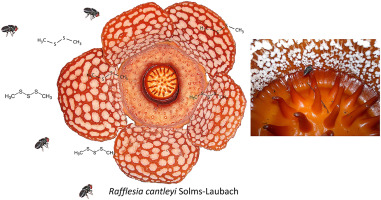当前位置:
X-MOL 学术
›
Phytochemistry
›
论文详情
Our official English website, www.x-mol.net, welcomes your feedback! (Note: you will need to create a separate account there.)
Pollinator specialization in the enigmatic Rafflesia cantleyi : A true carrion flower with species-specific and sex-biased blow fly pollinators
Phytochemistry ( IF 3.8 ) Pub Date : 2018-09-01 , DOI: 10.1016/j.phytochem.2018.06.005 Suk Ling Wee , Shwu Bing Tan , Andreas Jürgens
Phytochemistry ( IF 3.8 ) Pub Date : 2018-09-01 , DOI: 10.1016/j.phytochem.2018.06.005 Suk Ling Wee , Shwu Bing Tan , Andreas Jürgens

|
The plants of the enigmatic genus Rafflesia are well known for their gigantic flowers and their floral features such as pungent floral scent and vivid dark color, which mimics the food/brood sites of carrion. However, information on the pollination biology of this plant group remains limited and mostly anecdotal. In the present paper, we studied the floral volatiles of R. cantleyi Solms-Laubach and their role in pollinator attraction. To achieve these aims, the floral scent was collected in situ in the field using a dynamic headspace method followed by chemical analysis via GC-MS. The olfactory preferences of pollinators to the identified chemical compounds, were tested singly and in blends, in flight tunnel bioassays and compared with responses to headspace floral extracts. In addition, flower-visiting calliphorid flies and the local carrion fly community were sampled and identified. Five species of calliphorid flies (subfamilies of Chrysomyinae and Calliphorinae), all females, were found on the flowers, whereas nine species were found in the traps that were baited with tainted meat in the surrounding habitat. However, only flower visitors of one blow fly species, Chrysomya chani Kurahashi, were observed to carry R. cantleyi pollen after visiting male flowers. The floral volatiles emitted by male flowers in full bloom were dominated by two sulphur-containing compounds, dimethyl disulfide (DMDS) and dimethyl trisulfide (DMTS). These were accompanied by other minor compounds such as benzenoids (4), monoterpenoids (4), trace amounts of aliphatic compounds (1), and sesquiterpenes (1). In flight-tunnel bioassays, a female-specific positive response of C. chani flies to individual DMDS, DMTS, and a blend of DMDS and DMTS was evident. Our findings suggest that R. cantleyi biochemically mimics carrion and that relative ratio of oligosulfides in the floral scent play a key role in sex-biased pollinator specialization, attracting only female C. chani carrion flies to the flowers.
中文翻译:

神秘大王花的传粉者专业化:一种真正的腐肉花,具有物种特异性和性别偏见的吹蝇传粉者
神秘的大王花属植物以其巨大的花朵和花香特征而闻名,例如刺鼻的花香和鲜艳的深色,模仿腐肉的食物/繁殖场所。然而,关于该植物群授粉生物学的信息仍然有限,而且大多是轶事。在本文中,我们研究了 R. cantleyi Solms-Laubach 的花挥发物及其在传粉媒介吸引力中的作用。为了实现这些目标,使用动态顶空方法在现场原位收集花香,然后通过 GC-MS 进行化学分析。传粉者对已识别化合物的嗅觉偏好在飞行隧道生物测定中单独和混合进行了测试,并与对顶空花提取物的反应进行了比较。此外,对访花的蝾螈蝇和当地的腐肉蝇群落进行了采样和鉴定。在花上发现了五种苍蝇(Chrysomyinae 和 Calliphorinae 亚科),都是雌性,而在周围栖息地用受污染的肉作为诱饵的陷阱中发现了九种。然而,只有一种苍蝇物种 Chrysomya chani Kurahashi 的花访客在访问雄花后被观察到携带 R. cantleyi 花粉。雄花盛开时释放的花挥发物主要是两种含硫化合物,二甲基二硫化物(DMDS)和二甲基三硫化物(DMTS)。这些伴随着其他次要化合物,如苯类 (4)、单萜 (4)、痕量脂肪族化合物 (1) 和倍半萜烯 (1)。在飞行隧道生物测定中,C. chani 果蝇对个体 DMDS、DMTS 以及 DMDS 和 DMTS 的混合有明显的雌性特异性阳性反应。我们的研究结果表明,R. cantleyi 在生化上模拟腐肉,并且花香中低聚硫化物的相对比例在性别偏向的传粉者专业化中起着关键作用,仅吸引雌性 C. chani 腐肉飞向花朵。
更新日期:2018-09-01
中文翻译:

神秘大王花的传粉者专业化:一种真正的腐肉花,具有物种特异性和性别偏见的吹蝇传粉者
神秘的大王花属植物以其巨大的花朵和花香特征而闻名,例如刺鼻的花香和鲜艳的深色,模仿腐肉的食物/繁殖场所。然而,关于该植物群授粉生物学的信息仍然有限,而且大多是轶事。在本文中,我们研究了 R. cantleyi Solms-Laubach 的花挥发物及其在传粉媒介吸引力中的作用。为了实现这些目标,使用动态顶空方法在现场原位收集花香,然后通过 GC-MS 进行化学分析。传粉者对已识别化合物的嗅觉偏好在飞行隧道生物测定中单独和混合进行了测试,并与对顶空花提取物的反应进行了比较。此外,对访花的蝾螈蝇和当地的腐肉蝇群落进行了采样和鉴定。在花上发现了五种苍蝇(Chrysomyinae 和 Calliphorinae 亚科),都是雌性,而在周围栖息地用受污染的肉作为诱饵的陷阱中发现了九种。然而,只有一种苍蝇物种 Chrysomya chani Kurahashi 的花访客在访问雄花后被观察到携带 R. cantleyi 花粉。雄花盛开时释放的花挥发物主要是两种含硫化合物,二甲基二硫化物(DMDS)和二甲基三硫化物(DMTS)。这些伴随着其他次要化合物,如苯类 (4)、单萜 (4)、痕量脂肪族化合物 (1) 和倍半萜烯 (1)。在飞行隧道生物测定中,C. chani 果蝇对个体 DMDS、DMTS 以及 DMDS 和 DMTS 的混合有明显的雌性特异性阳性反应。我们的研究结果表明,R. cantleyi 在生化上模拟腐肉,并且花香中低聚硫化物的相对比例在性别偏向的传粉者专业化中起着关键作用,仅吸引雌性 C. chani 腐肉飞向花朵。



























 京公网安备 11010802027423号
京公网安备 11010802027423号